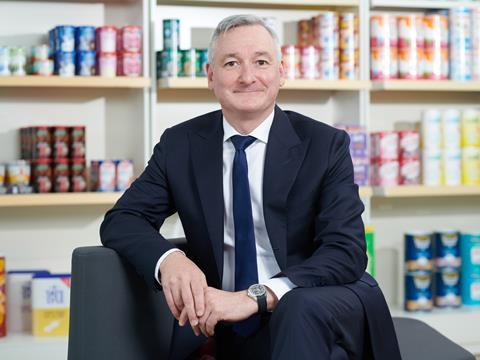
Pringles recently announced a new 90% paper tube that is made of recycled paper and replaces the steel base of the previous design with a paper alternative. How does it compare with the solution it replaced, and what are its sustainability credentials? To find out, we caught up with Seàn Cairns, President – Global Rigid Paper and Closures (RPC) at Sonoco, who collaborated with Pringles to create the solution.
To start with, could you introduce the new tube and talk a bit about its construction? It’s 90% paper – what is the other 10% and where does it appear in the pack?
The new tube is a remarkable innovation in packaging. It is primarily made of 90% paper, which makes it highly sustainable and recyclable in the UK’s waste paper stream. The remaining 10% is dedicated to the inner liner, a crucial component that ensures the protection and freshness of the delicious Pringles chips.
The inner liner is a specially designed barrier that prevents any material, gas, or humidity from migrating into the can. It consists of multiple layers of foils and films that create a shield, maintaining the original flavour and crispness of the chips even after a long shelf life. This innovative feature guarantees that every bite of Pringles is as delightful as the first.
Why was Pringles keen to transition to a new format?
Kellanova (Pringles’ parent company) was determined to embrace the new format of the recyclable Pringles tube for several reasons. Firstly, it aligns with their commitment to sustainability and reducing their environmental footprint. By utilising paper as the primary material for the tube, we are significantly reducing our reliance on other materials and promoting a more eco-conscious approach to packaging.
Furthermore, the transition to the new format was driven by our dedication to enhancing the overall consumer experience. The innovative design and construction of the tube not only ensure the protection and freshness of the chips but also provide a convenient and user-friendly packaging solution.
Could you take us behind the scenes to look at the R&D process? What were the main problems that had to be overcome?
The research and development process behind the new tube was an intricate and challenging journey. The main obstacle we had to overcome was the transition of the tube’s bottom from metal to paper. While it may seem like a simple change, the process involved complex chemistry and technical considerations.
We revolutionised the closing operation of the tube’s bottom by replacing the traditional seaming process with a sealing process. This required the implementation of new technologies, machinery, and a completely different chemistry. Unlike the seaming process, which relies on mechanical mechanisms, the sealing process involves the polymerisation of polyethylene.
To bring this innovative concept to life, Sonoco, developed groundbreaking equipment specifically designed for this closing technology. This equipment is unparalleled in the market and is protected by patents.
One of the significant challenges we faced was achieving the desired closing speed of up to 450 tubes per minute while working with the limitations of the paper material. However, our dedicated team of experts successfully developed the ideal material and machinery for this bottom closure, ensuring optimal performance and efficiency.
How does it compare to the previous model in terms of functionality, recyclability, and general sustainability? Have any LCAs been undertaken to compare its carbon footprint to the previous tube?
The new tube represents a significant leap forward in terms of functionality, recyclability, and overall sustainability compared to its predecessor. With its 90% paper composition, the new tube is widely recyclable, making it an excellent choice for environmentally conscious consumers. By using paper as the primary material, we are reducing our reliance on non-recyclable materials and promoting a more sustainable packaging solution.
Replacing metal with paper for the closing of the tube significantly improves the carbon footprint of the packaging. Industrial-scale recycling trials show good results and compatibility with existing sorting and recycling infrastructure. The predominant use of recycling paper closes the material loop and paves the way for a sustainable and circular packaging.
How does this move fit into both Pringles and Sonoco’s overall sustainability strategies?
This move perfectly aligns with both Kellanova and Sonoco’s overarching sustainability strategies. Sonoco has always been committed to reducing our environmental impact and finding innovative solutions to promote sustainability. The transition from composite to paper packaging boosts the use of renewable sources and underlines the remarkable circularity of paper in packaging production and recycling.
Similarly, Kellanova shares our vision for a greener future and has dedicated its efforts to investing in cutting-edge sustainable packaging solutions. The collaboration between Kellanova and Sonoco in creating the new tube showcases our joint commitment to environmental stewardship and sets a benchmark for the industry.
If you liked this article, you might also enjoy:
The L’Oréal approach to packaging sustainability
The way we talk about plastic needs to change – here’s how to get it right
What steps is Apple taking to make its packaging more sustainable?
The Danone approach to packaging sustainability





















1 Reader's comment